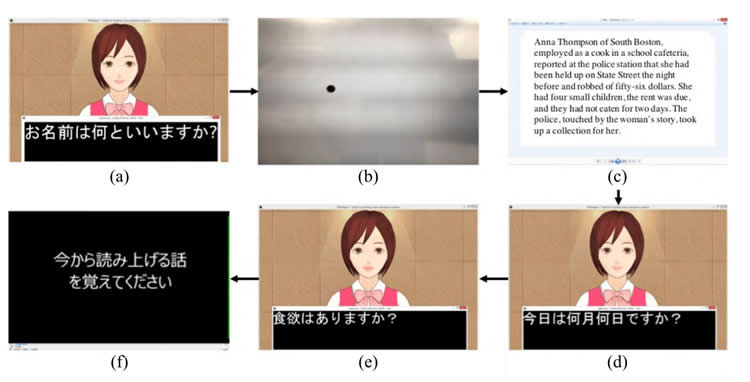Summary: Researchers report it may be possible to detect dementia from human interaction with a computerized avatar and machine learning algorithms.
Source: Osaka University.
Diagnosis of dementia was made via cognitive function tests such as Mini-Mental State Examination (MMSE) and medical imaging systems at hospitals, a fairly large system for the purpose. As our population ages, an increasing number of people are developing dementia. Thus, easy-to-use dementia detection tests are sought after. In previous studies, diagnoses were made mainly using neuropsychological questions, so habituation to the same questions lowered performance in detecting dementia.
A joint group of researchers from Osaka University and Nara Institute of Science and Technology demonstrated that it was possible to detect dementia from conversations in human-agent interaction. This technique has been realized through machine-learning: a machine learns characteristics of sounds of elderly people who answered easy questions from avatars on a computer.
The researchers proposed machine learning algorithms for detecting signs of dementia in its early stages, developing a dementia detection system using interactive computer avatars. They created a model for machine learning based on features of speech, language, and faces from recorded dialogues with elderly participants. Through machine learning, a computer came to able to distinguish individuals with dementia from healthy controls at a rate of 90 percent in 6 questions (2-3 minutes per question).
The team prepared fixed questions based on neuropsychological tests and random questions not based on specific tests, recording interactive data of spoken dialogues with avatars from 12 participants (individuals diagnosed with dementia by a psychiatrist according to the diagnosis criteria Diagnostic and Statistical Manual of Mental Disorders (DSM)-IV) and 12 healthy controls. They extracted speech, language, and image features from the recorded data, creating a model for detecting dementia and enabling a computer to learn for itself to detect dementia.

As a result, the computer was able to distinguish between healthy controls and individuals with dementia with an accuracy of 92%. It was found that dementia could be distinguished with high accuracy by combining features of dementia, such as delay in response to questions from avatars depending on the content of questions, intonation, articulation rate of the voice, and the percentage of nouns and verbs in utterance.
Senior author Takashi Kudo says, “If this technology is further developed, it will become possible to know whether or not an elderly individual is in the early stages of dementia through conversation with computer avatars at home on a daily basis. It will encourage them to seek medical help, leading to early diagnosis.”
Funding: This research was supported by Japan Society for the Promotion of Science (JSPS), Yanmar Innovation Lab.
Source: Saori Obayashi – Osaka University
Publisher: Organized by NeuroscienceNews.com.
Image Source: NeuroscienceNews.com image is credited toOsaka University.
Original Research: Open access research for “Detecting Dementia Through Interactive Computer Avatars” by Tanaka et al. in IEEE Journal of Translational Engineering in Health and Medicine. Published September 2018.
doi:10.1109/JTEHM.2017.2752152
[cbtabs][cbtab title=”MLA”]Osaka University”Computer Avatars Play a Part in Dementia Detection.” NeuroscienceNews. NeuroscienceNews, 13 September 2018.
<https://neurosciencenews.com/avatar-dementia-9861/>.[/cbtab][cbtab title=”APA”]Osaka University(2018, September 13). Computer Avatars Play a Part in Dementia Detection. NeuroscienceNews. Retrieved September 13, 2018 from https://neurosciencenews.com/avatar-dementia-9861/[/cbtab][cbtab title=”Chicago”]Osaka University”Computer Avatars Play a Part in Dementia Detection.” https://neurosciencenews.com/avatar-dementia-9861/ (accessed September 13, 2018).[/cbtab][/cbtabs]
Abstract
Detecting Dementia Through Interactive Computer Avatars
This paper proposes a new approach to automatically detect dementia. Even though some works have detected dementia from speech and language attributes, most have applied detection using picture descriptions, narratives, and cognitive tasks. In this paper, we propose a new computer avatar with spoken dialog functionalities that produces spoken queries based on the mini-mental state examination, the Wechsler memory scale-revised, and other related neuropsychological questions. We recorded the interactive data of spoken dialogues from 29 participants (14 dementia and 15 healthy controls) and extracted various audiovisual features. We tried to predict dementia using audiovisual features and two machine learning algorithms (support vector machines and logistic regression). Here, we show that the support vector machines outperformed logistic regression, and by using the extracted features they classified the participants into two groups with 0.93 detection performance, as measured by the areas under the receiver operating characteristic curve. We also newly identified some contributing features, e.g., gap before speaking, the variations of fundamental frequency, voice quality, and the ratio of smiling. We concluded that our system has the potential to detect dementia through spoken dialog systems and that the system can assist health care workers. In addition, these findings could help medical personnel detect signs of dementia.






